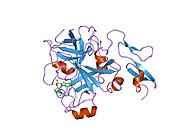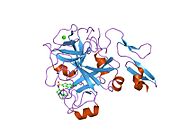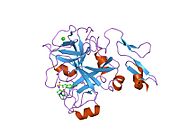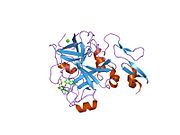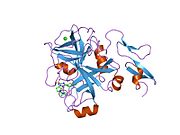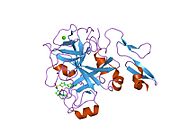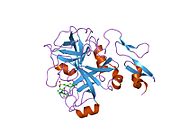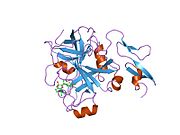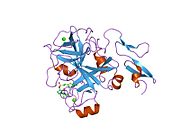Factor X
Template:PBB Factor X, also known by the eponym Stuart-Prower factor or as prothrombinase, is an enzyme (EC 3.4.21.6) of the coagulation cascade. It is a serine endopeptidase (protease group S1).
Physiology
Factor X is synthesized in the liver and requires vitamin K for its synthesis.
Factor X is activated into factor Xa by both factor IX (with its cofactor, factor VIII in a complex known as intrinsic Xase) and factor VII with its cofactor, tissue factor (a complex known as extrinsic Xase). It is therefore the first member of the final common pathway or thrombin pathway.
It acts by cleaving prothrombin in two places (an arg-thr and then an arg-ile bond), which yields the active thrombin. This process is optimized when factor Xa is complexed with activated co-factor V in the prothrombinase complex.
Factor Xa is inactivated by protein Z-dependent protease inhibitor (ZPI), a serine protease inhibitor (serpin). The affinity of this protein for factor Xa is increased 1000-fold by the presence of protein Z, while it does not require protein Z for inactivation of factor XI. Defects in protein Z lead to increased factor Xa activity and a propensity for thrombosis.
The half life of factor X is 40–45 hours.
Structure of Factor Xa
The first crystal structure of human factor Xa was deposited in May 1993. Till now total 191 crystal structures of factor Xa with various inhibitors have been deposited in the protein data bank. The active site of factor Xa is divided into four sub pockets as S1, S2, S3 and S4. The S1 subpocket determines the major component of selectivity and binding. The S2 sub-pocket is small, shallow and not well defined. It merges with the S4 subpocket. The S3 sub-pocket is located on the rim of the S1 pocket and is quite exposed to solvent. The S4 sub-pocket has 3 ligand binding domains, namely the "hydrophobic box", the "cationic hole" and the water site. Factor Xa inhibitors generally bind in an L-shaped conformation, where one group of the ligand occupies the anionic S1 pocket lined by residues Asp189, Ser195, and Tyr228, and another group of the ligand occupies the aromatic S4 pocket lined by residues Tyr99, Phe174, and Trp215. Typically, a fairly rigid linker group bridges these two interaction sites.[1]
Genetics
The human factor X gene is located on the thirteenth chromosome (13q34).
Role in disease
Inborn deficiency of factor X is very rare (1:500,000), and may present with epistaxis (nosebleeds), hemarthrosis (bleeding into joints) and gastrointestinal blood loss. Apart from congenital deficiency, low factor X levels may occur occasionally in a number of disease states. For example, factor X deficiency may be seen in amyloidosis, where factor X is adsorbed to the amyloid fibrils in the vasculature.
Deficiency of vitamin K or antagonism by warfarin (or similar medication) leads to the production of an inactive factor X. In warfarin therapy, this is desirable to prevent thrombosis. As of late 2007, four out of five emerging anti-coagulation therapeutics targeted this enzyme.[2]
Inhibiting Factor Xa would offer an alternate method for anticoagulation. Direct Xa inhibitors are popular anticoagulants.
Therapeutic use
Factor X is part of fresh frozen plasma and the prothrombinase complex. The only commercially available concentrate is 'Factor X P Behring' manufactured by CSL Behring.[3] Although in 2013 Bio Products Laboratory Limited in the United Kingdom was inspected by the FDA as part of a licence application for the first high purity Factor X product available to patients.
Use in Biochemistry
The Factor Xa protease can be used in biochemistry to cleave off protein tags that improve expression or purification of a protein of interest. Its preferred cleavage site (after the arginine in ile-glu/asp-gly-arg) can easily be engineered between a tag sequence and the protein of interest. After expression and purification, the tag is then proteolytically removed by Factor Xa.
Factor Xa
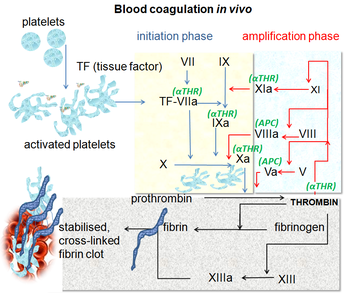
Factor Xa is the activated form of the coagulation factor thrombokinase, known eponymously as Stuart-Prower factor. Factor X is an enzyme, a serine endopeptidase, which plays a key role at several stages of the coagulation system. Factor X is synthesized in the liver. The most commonly used anticoagulants in clinical practice, warfarin and the heparin series of anticoagulants and fondaparinux, act to inhibit the action of Factor Xa in various degrees.
Traditional models of coagulation developed in the 1960s envisaged two separate cascades, the extrinsic (tissue factor (TF)) pathway and the intrinsic pathway. These pathways converge to a common point, the formation of the Factor Xa/Va complex which together with calcium and bound on a phospholipids surface generate thrombin (Factor IIa) from prothrombin (Factor II).
A new model, the cell-based model of anticoagulation appears to explain more fully the steps in coagulation. This model has three stages: 1) initiation of coagulation on TF-bearing cells, 2) amplification of the procoagulant signal by thrombin generated on the TF-bearing cell and 3) propagation of thrombin generation on the platelet surface. Factor Xa plays a key role in all three of these stages.[4]
In stage 1, Factor VII binds to the transmembrane protein TF on the surface of cells and is converted to Factor VIIa. The result is a Factor VIIa/TF complex which catalyzes the activation of Factor X and Factor IX. Factor Xa formed on the surface of the TF-bearing cell interacts with Factor Va to form the prothrombinase complex which generates small amounts of thrombin on the surface of TF-bearing cells.
In stage 2, the amplification stage, if enough thrombin has been generated, then activation of platelets and platelet associated cofactors occurs.
In stage 3, thrombin generation, Factor XIa activates free Factor IX on the surface of activated platelets. The activated Factor IXa with Factor VIIIa forms the "tenase" complex. This "tenase" complex activates more Factor X, which in turn forms new prothrombinase complexes with Factor Va. Factor Xa is the prime component of the prothrombinase complex which converts large amounts of prothrombin—the "thrombin burst". Each molecule of Factor Xa can generate 1000 molecules of thrombin. This large burst of thrombin is responsible for fibrin polymerization to form a thrombus.
Inhibition of the synthesis or activity of Factor X is the mechanism of action for many anticoagulants in use today. Warfarin, a synthetic derivative of coumarin, is the most widely used oral anticoagulant in the US. In some European countries, other coumarin derivatives (phenprocoumon and acenocoumarol) are used. These agents are vitamin K antagonists (VKA). Vitamin K is essential for the hepatic synthesis of Factors II (prothrombin), VII, IX and X.
Heparin (unfractionated heparin) and its derivatives low molecular weight heparin (LMWH) bind to a plasma cofactor, antithrombin (AT) to inactivate several coagulation factors IIa, Xa, XIa and XIIa. The affinity of unfractionated heparin and the various LMWHs for Factor Xa varies considerably. The efficacy of heparin-based anticoagulants increases as selectivity for Factor Xa increases. LMWH shows increased inactivation of Factor Xa compared to unfractionated heparin, and fondaparinux, an agent based on the critical pentasacharide sequence of heparin, shows more selectivity than LMWH. This inactivation of Factor Xa by heparins is termed "indirect" since it relies on the presence of AT and not a direct interaction with Factor Xa.
Recently a new series of specific, direct acting inhibitors of Factor Xa has been developed. These include the drugs rivaroxaban, apixaban, betrixaban, LY517717, darexaban (YM150), edoxaban and 813893. These agents have several theoretical advantages over current therapy. They may be given orally. They have rapid onset of action. And they may be more effective against Factor Xa in that they inhibit both free Factor Xa and Factor Xa in the prothrombinase complex.[5]
History
American and British scientists described deficiency of factor X independently in 1953 and 1956, respectively. As with some other coagulation factors, the factor was initially named after these patients, a Mr Rufus Stuart (1921) and a Miss Audrey Prower (1934).
Interactions
Factor X has been shown to interact with Tissue factor pathway inhibitor.[6]
References
- ^ Presentation on Direct Factor Xa Inhibitors
- ^ Ron Winslow (2007-12-10). "Race Is on for the Next Blood Thinner". Wall Street Journal. p. A12. Retrieved 2008-01-06.
The flurry of interest reflects increasing understanding of what doctors call the coagulation cascade... Four new blood thinners target an enzyme called factor Xa, one of several enzymes that play an important role in the cascade.
{{cite news}}: Unknown parameter|coauthors=ignored (|author=suggested) (help) - ^ Mark Brooker (2008): "Registry of Clotting Factor Concentrates". Eighth Edition, 2008, World Federation of Hemophilia
- ^ Hoffman M (2007). "Coagulation 2006: A Modern View of Hemostasis". Hematology and Oncology Clinics of North America. 21 (1): 1–11. doi:10.1016/j.hoc.2006.11.004. PMID 17258114.
{{cite journal}}: Unknown parameter|coauthors=ignored (|author=suggested) (help) - ^ Turpie AG (2007). "Oral, Direct Factor Xa Inhibitors in Development for the Prevention and Treatment of Thromboembolic Diseases". Arterioscler Thromb Vasc Biol. 27 (6): 1238–47. doi:10.1161/ATVBAHA.107.139402. PMID 17379841.
- ^ Broze, G J (1988). "The lipoprotein-associated coagulation inhibitor that inhibits the factor VII-tissue factor complex also inhibits factor Xa: insight into its possible mechanism of action". Blood. 71 (2). UNITED STATES: 335–43. ISSN 0006-4971. PMID 3422166.
{{cite journal}}: Unknown parameter|coauthors=ignored (|author=suggested) (help); Unknown parameter|month=ignored (help)
External links
- The MEROPS online database for peptidases and their inhibitors: S01.216
- med/3495 at eMedicine
- Factor X deficiency

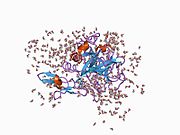
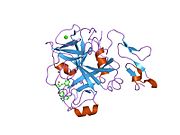
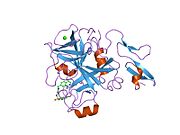
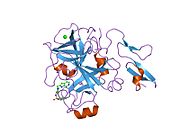
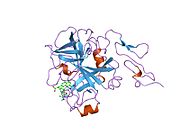
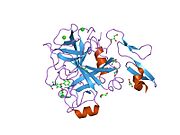
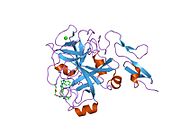


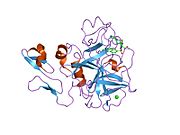
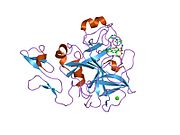
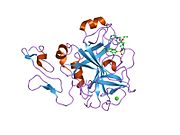
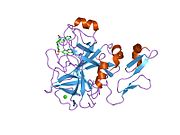
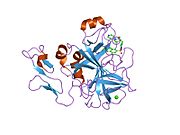
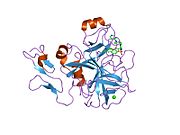
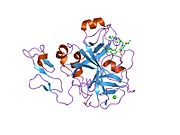
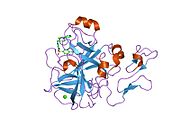
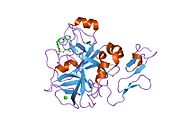
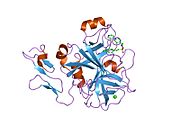

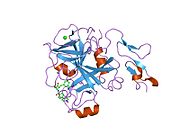
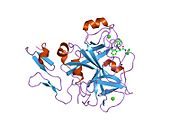

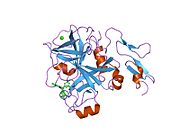
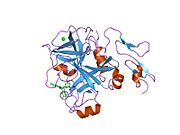
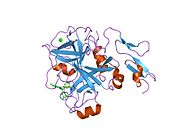
![1mq5: Crystal Structure of 3-chloro-N-[4-chloro-2-[[(4-chlorophenyl)amino]carbonyl]phenyl]-4-[(4-methyl-1-piperazinyl)methyl]-2-thiophenecarboxamide Complexed with Human Factor Xa](http://up.wiki.x.io/wikipedia/commons/thumb/6/68/PDB_1mq5_EBI.jpg/180px-PDB_1mq5_EBI.jpg)
![1mq6: Crystal Structure of 3-chloro-N-[4-chloro-2-[[(5-chloro-2-pyridinyl)amino]carbonyl]-6-methoxyphenyl]-4-[[(4,5-dihydro-2-oxazolyl)methylamino]methyl]-2-thiophenecarboxamide Complexed with Human Factor Xa](http://up.wiki.x.io/wikipedia/commons/thumb/a/a4/PDB_1mq6_EBI.jpg/180px-PDB_1mq6_EBI.jpg)
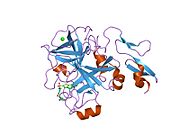
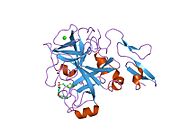
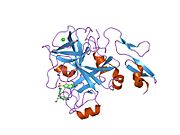
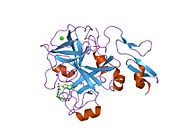
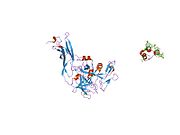
![1v3x: Factor Xa in complex with the inhibitor 1-[6-methyl-4,5,6,7-tetrahydrothiazolo(5,4-c)pyridin-2-yl] carbonyl-2-carbamoyl-4-(6-chloronaphth-2-ylsulphonyl)piperazine](http://up.wiki.x.io/wikipedia/commons/thumb/7/70/PDB_1v3x_EBI.jpg/180px-PDB_1v3x_EBI.jpg)
![1wu1: Factor Xa in complex with the inhibitor 4-[(5-chloroindol-2-yl)sulfonyl]-2-(2-methylpropyl)-1-[[5-(pyridin-4-yl) pyrimidin-2-yl]carbonyl]piperazine](http://up.wiki.x.io/wikipedia/commons/thumb/1/17/PDB_1wu1_EBI.jpg/180px-PDB_1wu1_EBI.jpg)
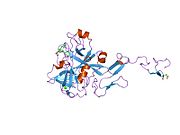
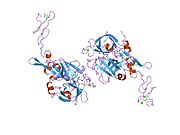

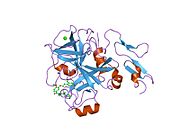
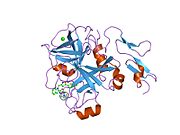
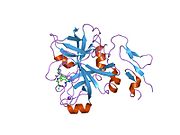
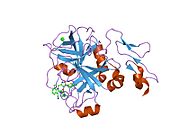
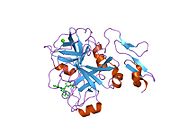
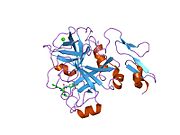

![2d1j: Factor Xa in complex with the inhibitor 2-[[4-[(5-chloroindol-2-yl)sulfonyl]piperazin-1-yl] carbonyl]thieno[3,2-b]pyridine n-oxide](http://up.wiki.x.io/wikipedia/commons/thumb/a/ae/PDB_2d1j_EBI.jpg/180px-PDB_2d1j_EBI.jpg)
![2fzz: Factor Xa in complex with the inhibitor 1-(3-amino-1,2-benzisoxazol-5-yl)-6-(2'-(((3r)-3-hydroxy-1-pyrrolidinyl)methyl)-4-biphenylyl)-3-(trifluoromethyl)-1,4,5,6-tetrahydro-7h-pyrazolo[3,4-c]pyridin-7-one](http://up.wiki.x.io/wikipedia/commons/thumb/e/e1/PDB_2fzz_EBI.jpg/180px-PDB_2fzz_EBI.jpg)
![2g00: Factor Xa in complex with the inhibitor 3-(6-(2'-((dimethylamino)methyl)-4-biphenylyl)-7-oxo-3-(trifluoromethyl)-4,5,6,7-tetrahydro-1H-pyrazolo[3,4-c]pyridin-1-yl)benzamide](http://up.wiki.x.io/wikipedia/commons/thumb/b/b8/PDB_2g00_EBI.jpg/180px-PDB_2g00_EBI.jpg)


